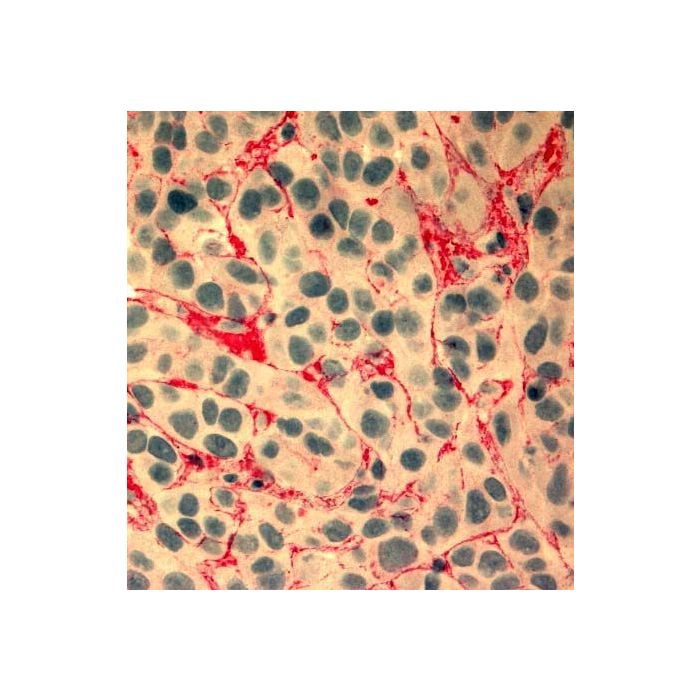Cookie Policy: This site uses cookies to improve your experience. You can find out more about our use of cookies in our Privacy Policy. By continuing to browse this site you agree to our use of cookies.
AdipoGen Life Sciences
anti-Fibronectin (EDA), mAb (blocking) (IST-9) (preservative free)

| Product Details | |
|---|---|
| Synonyms | FN; Cold-insoluble Globulin; CIG; Fibronectin (EIIIA) |
| Product Type | Monoclonal Antibody |
| Properties | |
| Clone | IST-9 |
| Isotype | Mouse IgG1 |
| Source/Host | Purified from concentrated hybridoma tissue culture supernatant. |
| Immunogen/Antigen | Recombinant Extra Domain A (EDA) region of human cellular fibronectin. |
| Label/Conjugates | Preservative Free |
| Application |
ELISA |
| Crossreactivity |
Chicken Cow Dog Human Monkey Mouse Pig Rat |
| Specificity |
Recognizes an epitope located in the EDA sequence of human cellular fibronectin (FN). Does not detect extracellular FN (plasma FN). Cross-reacts with mouse, rat, monkey, pig, dog, cow and chicken fibronectin EDA (according to literature). |
| Purity | ≥95% (SDS-PAGE) |
| Purity Detail | Epitope affinity purifed on recombinant fragment of fibronectin EDA. |
| Concentration | Lot dependent |
| Formulation | Sterile liquid. In PBS. |
| Isotype Negative Control | |
| Shipping and Handling | |
| Shipping | BLUE ICE |
| Short Term Storage | +4°C |
| Long Term Storage | -20°C |
| Handling Advice |
After opening, prepare aliquots and store at -20°C. Avoid freeze/thaw cycles. |
| Use/Stability | Stable for at least 1 year after receipt when stored at -20°C. |
| Documents | |
| MSDS |
 Download PDF Download PDF |
| Product Specification Sheet | |
| Datasheet |
 Download PDF Download PDF |
Fibronectin is a major component of the extracellular matrix that binds to integrins, cell surfaces and various compounds including collagen, fibrin, heparin, DNA and actin. It occurs in two main forms: plasma and cellular fibronectin. EDA (Extra Domain A)-containing cellular fibronectin (EDA-FN) plays a major role in cell adhesion, growth, migration and differentiation and it is important for processes such as wound healing and embryonic development. It is associated with fibroblast differentiation by increasing α-SMA expression, collagen deposition, cell contractility and focal adhesion kinase (FAK) activation. EDA-FN promotes cell spread by interacting with the integrins α5-β1, α4-β1 and α9-β1 and has been shown to promote angiogenesis, lymphangiogenesis and metastasis of colorectal tumors. In transformed or tumor-derived cells the EDA segment is about 10-times higher than in fibronectin from normal fibroblasts and it may therefore be a significant marker for malignancy.
- Monoclonal antibodies in the analysis of fibronectin isoforms generated by alternative splicing of mRNA precursors in normal and transformed human cells: L. Borsi, et al.; J. Cell Biol. 104, 595 (1987)
- Localization of the cellular-fibronectin-specific epitope recognized by the monoclonal antibody IST-9 using fusion proteins expressed in E. coli: B. Carnemolla, et al.; FEBS Lett. 215, 269 (1987)
- Molecular and immunologic differences in canine fibronectins from articular cartilage and plasma: N. Burton-Wurster & G. Lust; Arch. Biochem. Biophys. 269, 32 (1989)
- Coordinate oncodevelopmental modulation of alternative splicing of fibronectin pre-messenger RNA at ED-A, ED-B, and CS1 regions in human liver tumors: F. Oyama, et al.; Cancer Res. 53, 2005 (1993)
- Endogenous fibronectin of blood polymorphonuclear leukocytes: immunochemical characterization and subcellular localization: R. Salcedo, et al.; Exp. Cell Res. 233, 25 (1997)
- The fibronectin domain ED-A is crucial for myofibroblastic phenotype induction by transforming growth factor-beta1: G. Serini, et al.; J. Cell Biol. 142, 873 (1998)
- Identification of two amino acids within the EIIIA (ED-A) segment of fibronectin constituting the epitope for two function-blocking monoclonal antibodies: Y.F. Liao, et al.; J. Biol. Chem. 274, 17876 (1999)
- Engagement of alpha4beta7 integrins by monoclonal antibodies or ligands enhances survival of human eosinophils in vitro: J. Meerschaert, et al.; J. Immunol. 163, 6217 (1999)
- Segmental antigen challenge increases fibronectin in bronchoalveolar lavage fluid: J. Meerschaert, et al.; Am. J. Respir. Crit. Care Med. 159, 619 (1999)
- Deletion of the alternatively spliced fibronectin EIIIA domain in mice reduces atherosclerosis: M.H. Tan, et al.; Blood 104, 11 (2004)
- Fibronectin-alpha4beta1 integrin interactions regulate metalloproteinase-9 expression in steatotic liver ischemia and reperfusion injury: C. Moore, et al.; Am. J. Pathol. 170, 567 (2007)
- Identification of the peptide sequences within the EIIIA (EDA) segment of fibronectin that mediate integrin alpha9beta1-dependent cellular activities: A.V. Shinde, et al.; J. Biol. Chem. 283, 2858 (2008)
- Fibronectin extra domain A (EDA) sustains CD133+/CD44+ subpopulation of colorectal cancer cells: J. Ou, et al.; Stem Cell Res. 11, 820 (2013)
- Irigenin, a novel lead from Western Himalayan chemiome inhibits Fibronectin-Extra Domain A induced metastasis in lung cancer cells: A. Amin, et al.; Sci. Rep. 6, 37151 (2016)
- Detection of soluble ED-A+ fibronectin and evaluation as novel serum biomarker for cardiac tissue remodeling: B. Ziffels, et al.; Dis. Mark. 2016, ID3695454 (2016)
- Fibronectin Extra Domains tune cellular responses and confer topographically distinct features to fibril networks: G. Efthymiou, et al.; J. Cell Sci. 134, jcs252957 (2021)
- Cardiac inducing colonies halt fibroblast activation and induce cardiac/endothelial cells to move and expand via paracrine signaling: S. Mahapatra, et al.; Mol. Biol. Cell 33, ar96 (2022)
- Microcurrent-Mediated Modulation of Myofibroblasts for Cardiac Repair and Regeneration: D.B. Somesh, et al.; Int. J. Mol. Sci. 25, 3268 (2024)






